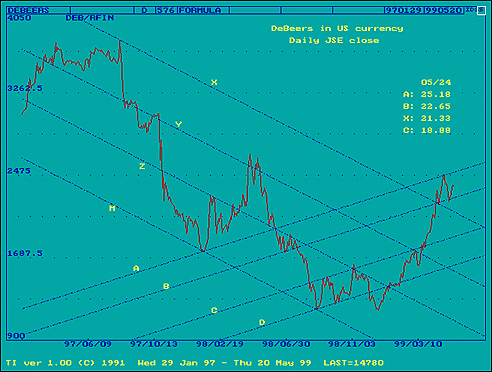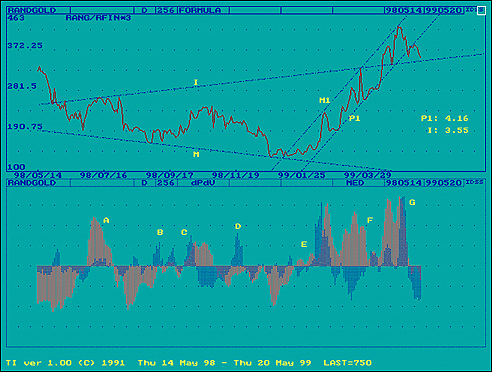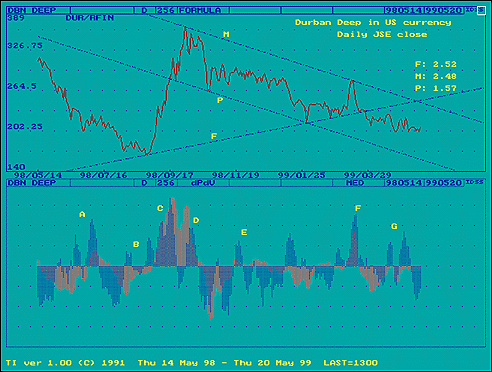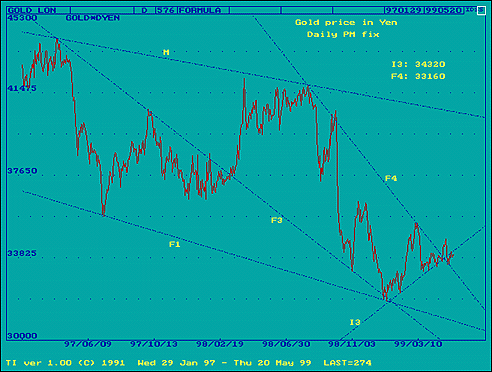Chart Symmetry
DeBeers; Randgold; Durban Deep; Gold Price in Yen
Chart Symmetry is designed around the observation that prices tend to change direction along certain preferred gradients. New readers are advised to read the first article in this series to discover how Chart Symmetry works. The link to this article is : https://www.gold-eagle.com/south_africa/regional_analysts/joubert020699.html
The prices shown for the lines are the values of the lines at the next time interval after the chart close. It is not a prediction that the price will suddenly move to reach that line overnight, but provides the reader a measure of the move that could take place if the price pattern does develop in the direction of that trend line. The steeper the line, the greater will be the change in the line value over time.
The key point to remember throughout is that the gradients of all secondary lines were derived from the gradient of the master line. The scope for the analyst to 'do his own thing' and develop a pre-conceived pattern is therefore quite limited. The patterns that are shown in the analyses are inherent in the charts, but these are not the only patterns that can be derived.
De Beers in US currency – calculated from JSE close. Daily close. (Last = $23.78)

The chart shows the same bear channel, X-M, used previously. Channel A-D has a gradient that is the shallower derivative of the gradient of line M.
The recent break above X, followed by a return to that line and then the rebound, was bullish.
However, the price then ran into resistance along a shallower bull channel, A-D. Future behaviour of the price will largely be determined by what happens with respect to line B. It is developing as the neck line of what might become a head & shoulders pattern once the neck line is penetrated.
Scenario 1: The price has reversed trend at B again to remain within the bull channel A-B – later to break higher through resistance at A. Bullish.
Scenario 2:. A break below support at line B within the near future completes the head & shoulders pattern. The count of the H&S has a target around $19.75 (i.e. a move below neck line B equal to the distance of the top of the head above line B.)
Preference: From just before Christmas last year, DeBeers had gained 110% in US dollar terms to reach resistance at A. This is an excellent performance and perhaps a correction is now due. The main companies in the Anglo American group – often referred to as "South Africa Incorporated" – have doubled in price over the past few months in anticipation of Anglo's listing in London this week. DeBeers, with a large stake in the group, have ridden on the coat tails. The question now is how AAC will perform in London and this in turn will influence DeBeers. While support at neck line B holds, Scenario 1 is in place. However, this changes rapidly if there should be a break below the neck line.
Randgold in US currency (ADR). Daily JSE close. (Last = $3.62)
Randgold's ADR price - shown in the top half of the chart - displays two key patterns.

The break higher from symmetrical megaphone I-M was a bullish event, but the market then ran out of steam at the top boundary of bull channel M1-P1. The break below the channel – followed by the usual goodbye kiss – is quite bearish.
The lower chart uses the dPdV indicator. Readers who are unfamiliar with this indicator can refer to the article at this link: https://www.gold-eagle.com/south_africa/regional_analysts/joubert042099.html for information on how the indicator is generated and interpreted.
A: The bear market rally in July 1998 (pink bars of price MACD above the base line) occurred on little increase in turnover (blue bars of volume MACD) and soon fizzled out when POG fell below $290.
B: Some sporadic buyer interest, indicated by spikes in the volume MACD, kept the price on an even keel during this period.
C: New demand and a recovery in POG had the price rising 30%+ in a short while. After then drifting mostly sideways for some weeks, sellers entered the market in quantity (at D) and, with no sustained demand as shown by declining turnover, the price just drifted lower.
E: After a first flicker of interest from buyers and a slight recovery in the price, strong demand sent turnover steeply higher. The price reacted strongly and continued higher on suddenly lower turnover -– the typical sustained bull trend, with few sellers in sight.
F: When the price topped out at the end of the initial run, buyers were quick to get back into the market – turnover picked up briefly on two occasions – having to chase the price as sellers withdrew to see how far the market would move this time.
G: Finally, just after the market peaked, heavy selling into what at first was good demand soon had buyers on the sidelines as POG fell away in response to the BoE news release. Since then turnover has dropped sharply, keeping the price under some pressure in the absence of new demand.
Scenario 1: The price continues lower on slack demand to break below key support at line I. The break back into the megaphone is bearish and the price is expected to remain under pressure. Such a break may well be used as a stop loss.
Scenario 2: The price rebounds off the top of megaphone I-M – thus giving a goodbye kiss on line I, with turnover rising to show the entry of new buyers. The price resumes the bull trend, probably at a shallower gradient than before.
Preference: Breaks from megaphones tend to be sharp and volatile. However, in this case resistance at the top of channel M1-P1 came into play and ended the rising trend. Since megaphones tend to be strong formations, good support at line I can be expected. On that basis, Scenario 1 is preferred – to be confirmed by an increase in volume as the price approaches I and buyers return to the market. However, support at line I is of great importance and the verdict changes rapidly to bearish with a break below support at line I, which becomes a real possibility if Randgold's turnover on the JSE remains low.
Durban Deep in US currency. Daily close. (Last = $2.01)
After a good increase of 124% late in 1998, the dollar price of Durban Deep entered a gradual bear trend, well contained in bear channel M-P, that eventually carried the price below key support at line F.
The lower half of the chart shows the volume analysis for DRD, using the JSE turnover figures. Blue bars are the turnover or volume MACD; pink bars are the price MACD. When many other gold shares showed substantial increases some time ago, DRD lagged. In an earlier report, the dPdV chart of Durban Deep was analysed in detail, and the conclusion was that there might be a large seller or sellers who appear to take advantage of every increase in demand to reduce their holding in Durban Deep.
After the large sell-off at D, demand increased on a number of occasions (blue bars above the base line at E-F) and every time the price either failed to react at all or the increase soon fizzled out – evidence that demand exceeds supply and probably an indication that there is a large pool of shares waiting to be sold.
Demand at the recent low in the price (G), had the price moving a little higher, but the turnover remained high until the price wilted again. More recently, turnover remained low as the fall in the gold price kept buyers on the sidelines.

Scenario 1: Turnover begins to increase again – early warning! – until the price reacts to new demand to take the price MACD above the base line, thus to confirm the early buy warning. The price then moves higher to test resistance at the top of the channel at M.
Scenario 2: A lack of buyer interest keeps the price under pressure. It continues to drift lower on reduced turnover. The price sinks into the lower half of the bear channel, M-P.
Preference: With POG still under pressure Scenario 2 has to be preferred.
Market sentiment on the JSE is decidedly negative on gold shares and turnover in the whole sector has been very low in recent days. Only an increase in POG and a rise in demand can improve both turnover and – perhaps only after absorbing some selling pressure as holders decide to get out while POG offers an opportunity – later the price as well.
Prospective buyers of Durban Deep, and other gold shares, should have a foot in the door – say 15-25% of budget already invested – while waiting with the remainder of one's funds to buy at a lower price or, alternatively, to buy aggressively if the gold price begins a recovery.
Spot Gold price in Yen. Daily PM fix. (Last = ¥33880)
The fact that the dollar price of gold has fallen below recent lows to approach levels of 20 years and longer ago, is well known. Two facts nevertheless stand out – gold is still doing better than most (other?) commodities that are back at price levels of the early 70's. Secondly, purchasers of gold elsewhere in the world still perceive the gold price in their own currencies as being in a rising trend.

This analysis of the price of gold in Yen is similar to a chart showed some months ago. As usual, all the lines were derived from M. M-F1 is a large megaphone, with F1 –F4 and F3-F4 as descending wedge formations. Line I3 is the inverse of F3.
The break higher from the two descending wedges, through resistance at F4, occurred during leg 4 – a leg that should have moved lower to line F1 (or F3?) to be complete before the final bull trend commenced with leg 5 of the wedge formation. Premature breaks tend to be quite volatile. Here the Yen price of gold strated off steeply, but then retreated back to line F4 in what would typically be a goodbye kiss – preparation to rebound into the definite bull trend.
The break below inverse line I3 is a bearish warning and offers some reason for concern.
Scenario 1: After the break below support at line I3 the POG in Yen continues lower along the outside of wedge F1-F4 until support at F1 is finally reached, many months from now. Bearish for the Yen price of gold, either because of a stronger Yen or a weak dollar price of gold, or as a combination of the two.
Scenario 2: The Yen price of gold bounces off line F4 into a new rising trend – either as a result of a very weak Yen or because of a stronger dollar price of gold, or as a combination of the two.
Preference: The longer the Yen price of gold remains below the resistance offered by line I3 – and the further it falls below that line – the more gloomy becomes the outlook for either the dollar or the dollar price of gold. Or both. Since a weak dollar and a weak dollar price of gold at the same time seems a little unlikely, failure to recover above I3 should be bearish for gold. A break above line I3 – currently at ¥34320 and rising to about ¥34600 three weeks from now – would be a first indication that the outlook for gold is improving. Or perhaps that the Yen is falling out of bed, which could also entice Japanese purchasers into the gold market as they look for protection of purchasing power.
Previous charts:
US 30-year T-bond: The yield has recovered in last week's rally to close just a fraction above significant market resistance at 5.735%. A US daily close below this level would be bullish for the near to medium term. Failure to break lower quite soon should be viewed as bearish for US bonds.
Previous Chart Symmetry analyses are in the Gold-Eagle archives and are accessible through the Index of Research/Top Analysts on the G-E home page.
















